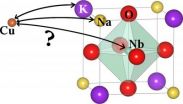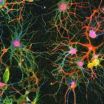(Press-News.org) A protein known to exist in the brain for more than 30 years, called 5-lipoxygenase, has been found to play a regulatory role in the formation of the amyloid beta in the brain, the major component of plaques implicated in the development of Alzheimer's disease, according to researchers at Temple University's School of Medicine.
The researchers also found that inhibitors of this protein currently used to control asthma could possibly be used to prevent or treat Alzheimer's disease.
The researchers published their findings, "5-Lipoxygenase as Endogenous Modulator of Amyloid Beta Formation in Vivo," in the Annals of Neurology.
According to Domenico Praticò, an associate professor of pharmacology in Temple's School of Medicine and the study's lead researcher, the 5-Lipoxygenase enzyme is found in abundance mainly in the region of the brain, the hippocampus, involved in memory.
Praticò and his team discovered that 5-lipoxygenase, which unlike most proteins in the brain increases its levels during the aging process. It also controls the activation state of another protein, called gamma secretase, a complex of four elements which are necessary and responsible for the final production of the amyloid beta, a peptide that when produced in excess deposits and forms plaques in the brain. Today the amount of these amyloid plaques in the brain is used as a measurement of the severity of Alzheimer's.
"What we found was 5-lipoxygenase regulates and controls the amount of total amyloid beta produced in the brain," said Praticò. "With aging, the more 5-lipoxygenase you have the more amyloid beta you're going to produce. This will translate into a higher risk to develop full Alzheimer's"
A previous study by Praticò, in which researchers crossed a mouse model of Alzheimer's with a mouse that did not genetically feature 5-lipoxygenase, demonstrated that a lack of this enzyme protein alone can reduce the amount of disease in the brain by up to half.
"It has been known for years that the 5-lipoxygenase is an important protein in other areas of the body, such as the lung, but nobody really cared about its role in the brain," he said. "Based on some previously know information, we questioned whether this enzyme was a primary or secondary player in the development of Alzheimer's. What we found was a new primary role for an old enzyme."
Praticò said that the key in the process was 5-lipoxygenase's direct control over the gamma secretase, the only source of amyloid beta in the brain. "If you can modulate this enzyme easily, then you can control the amount of total amyloid beta that is produced by the gamma secretase in the brain, thus controlling the amount of Alzheimer's disease."
Praticò said that armed with new information, new therapies could be developed to block the increase of 5-lipoxygenase levels in the aging brain, which would in turn prevent the formation of amyloid beta.
He said that there are several FDA-approved 5-lipoxygenase inhibitors currently being used for the treatment of asthma, and that the Temple researchers tested some of these inhibitors in the lab against the production of amyloid beat with initial positive results.
"These drugs are already on the market, they're inexpensive and, most importantly, they are already FDA-approved, so you wouldn't need to go through an intense drug discovery process," said Praticò. "So you could quickly begin a clinical trial to determine if there is a new application for an old drug against a disease where there is currently nothing."
INFORMATION:
The study was funded by the National Institutes of Health and the Alzheimer's Association Zenith Fellowship.
Copies of this study are available to working journalists and may be obtained by contacting Preston M. Moretz in Temple's Office of University Communications at pmoretz@temple.edu.
END
Retinitis pigmentosa is an inherited eye disorder characterized by progressive loss of vision that in many instances leads to legal blindness at the end stage.
In a ChIP-Seq based approach, the researchers identified a key regulatory role of the transcription factor Crx (Cone-rod homeobox) in the expression of retina-specific genes and thus described an important genetic basis for visual perception. In-depth analysis of Crx mediated regulation in photoreceptors with latest technology provided by Genomatix lead then to the identification of nonsense mutations in the human ...
New stars are born in the Universe around the clock – on the Milky Way, currently about ten per year. From the birth rate in the past, we can generally calculate how populated space should actually be. But the problem is that the results of such calculations do not match our actual observations. "There should actually be a lot more stars that we can see," says Dr. Jan Pflamm-Altenburg, astrophysicist at the Argelander-Institut für Astronomie of the University of Bonn.
So, where are those stars?
For years, astronomers worldwide have been looking for a plausible explanation ...
The casting sessions aren't just for movie stars, but what is involved in casting decisions that can launch fashion models to fame – or at the very least – to land a job? Stephanie Sadre-Orafai, a University of Cincinnati assistant professor and socio-cultural anthropologist, spent 11 months of fieldwork at a premiere casting agency in New York to uncover the decisions that happen behind the scenes of the glossy photos and slick commercials. Her research, "Polaroids and Go-Sees: Casting Encounters, Casting Epistemologies," was presented Nov. 17 at the 109th annual meeting ...
HOUSTON – (Nov. 18, 2010) – Discovery of a fifth gene defect and the identification of 47 DNA regions linked to thoracic aortic disease are the subject of studies released this month involving researchers at The University of Texas Health Science Center at Houston (UTHealth).
In both studies, the investigators have identified alterations in the genetic material or DNA that affect the ability of smooth muscle cells, which line the aorta and other blood vessels, to contract. This can lead to a weakening of the wall of the aorta, the main blood vessel leading out of the ...
Technical progress in the automobile industry is unbroken. But, the sector has still some hard nuts to crack: "Lead-free materials" is one of the challenges – hidden behind this challenge is a EU environmental directive which, based on a step-by-step plan, gradually bans all lead-containing materials and components from automotive vehicles – such as piezoelectric components. These elements are important for diesel engine injectors, for example, which control the supply of fuel to the combustion chamber.
The problem: Up to now lead-zirconate-titanate (PZT) is the material ...
A short push on the light switch – and the whole ceiling lights up in a uniform and pleasant color. This "illuminated sky" is not available as yet, but researchers from all over the world are working on it flat out. The technology behind this marvel is based on organic light-emitting diodes, or OLEDs for short. These diodes use special molecules to emit light as soon as current passes through them. Although the first OLEDs have only recently become available, they are small and expensive. A flat disk with a diameter of eight centimeters costs around Euro 250. Experts of ...
Scientists at Johns Hopkins have identified a compound that could be used to starve cancers of their sugar-based building blocks. The compound, called a glutaminase inhibitor, has been tested on laboratory-cultured, sugar-hungry brain cancer cells and, the scientists say, may have the potential to be used for many types of primary brain tumors.
The Johns Hopkins scientists, are inventors on patent applications related to the discovery, caution that glutaminase inhibitors have not been tested in animals or humans, but their findings may spark new interest in the glutaminase ...
PHILADELPHIA – Cells have their own version of the cut-and-paste editing function called splicing. Researchers at the University of Pennsylvania School of Medicine have documented a novel form of splicing in the cytoplasm of a nerve cell, which dictates a special form of a potassium channel protein in the outer membrane. The channel protein is found in the dendrites of hippocampus cells -- the seat of memory, learning, and spatial navigation -- and is involved in coordinating the electrical firing of nerve cells. Dendrites, which branch from the cell body of the neuron, ...
Montreal, November 18, 2010 – Schizophrenia is a mental disorder that differs between the sexes in terms of age at onset, symptomatology, response to medication, and structural brain abnormalities. Now, a new study from the Université de Montréal shows that there is gender difference between men and women's mental ability – with women performing better than men. These findings, published recently in, Schizophrenia Research, have implications for the more than 300 000 affected Canadians.
"We are the first to report sex differences in brain function of schizophrenics," ...
The Soufriere Hills Volcano on Montserrat erupted in 1995, and an international team of researchers has studied this volcano from land and sea since then to understand the workings of andesite volcanos more completely.
"To the extent that the Soufriere Hills Volcano is typical of andesitic dome building volcanoes, results from this research can be expected to apply more generally," said Barry Voight, professor emeritus of geosciences, Penn State.
Voight and R. S. J. Sparks, the Channing Wills professor of geology, Bristol University, guest edited and introduced a special ...



